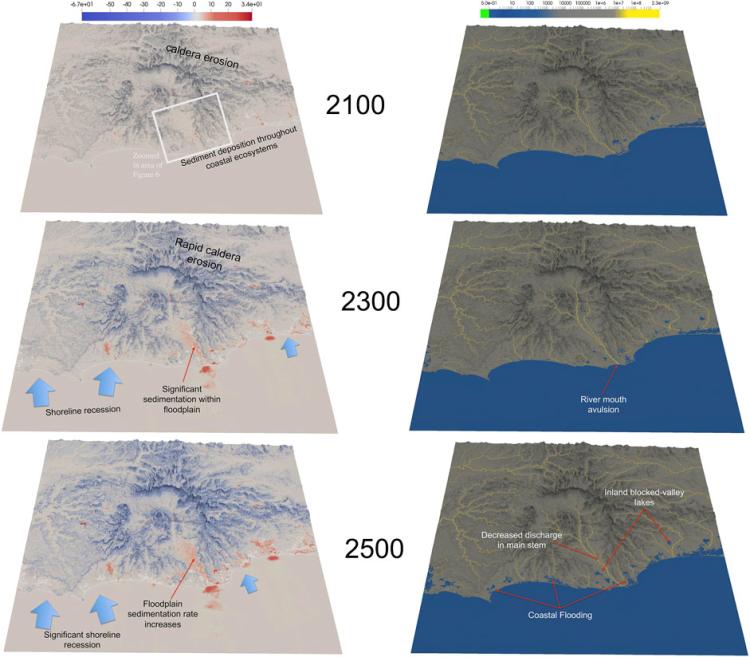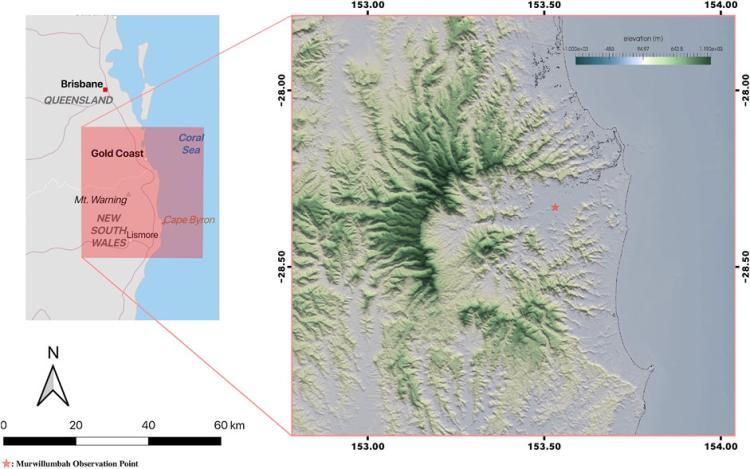Tweed Valley a ‘natural laboratory’ to test carbon sequestration theory
Olivine rock weathering would absorb small amounts of global CO2 pollution
Geoscientists have discovered a natural laboratory to test claims that the carbon captured during the erosion and weathering of common rocks could be a viable mitigation strategy against global warming.
That laboratory is the Tweed River valley in north-eastern New South Wales.

Visualisations of scenario 8.5: erosion and deposition. Left frame: Red regions indicate areas of deposition and blue regions indicate areas of erosion. Right frame: Visualizations of discharge with brighter yellow colours indicating greater discharge rates demonstrating dynamic differences between 2100, 2300, and 2500.
“When common rocks, known as olivine, chemically break down, they absorb carbon dioxide to form carbonates that can then be washed into the oceans,” said lead author of the study, Kyle Manley (EnvSt’18), now a graduate student at the University of Irvine in California.

Kyle Manley
“In that way, river valleys like the Tweed can act as carbon sinks.”
The carbonates formed in this process later become the shells of marine animals and corals. Over millions of years, these remnants can form huge undersea carbonate structures. Occasionally they are pushed above sea level, such as the White Cliffs of Dover in England.
In order to combat global warming, some have proposed olivine weathering and its carbon capture could be harnessed to absorb millions of tonnes of carbon dioxide from the atmosphere.
“But those ideas haven’t really been tested at scale,” said Manley, who started the study while studying at the School of Geosciences at the University of Sydney, completing it at the University of Colorado Boulder.
Research now published in the journal Frontiers in Earth Sciences, will allow scientists to test these claims in the Tweed catchment area and in other regions that act as carbon sinks.
Co-author Tristan Salles from the School of Geosciences at the University of Sydney said: “We ran seven scenarios up to 2100 and 2500 to see how much carbon might be absorbed in different climatic conditions.

Region of study is the Tweed River Caldera, the remnants of a collapsed volcano in north-east New South Wales and south-east Queensland, Australia.
“In all scenarios we estimate millions of tonnes of carbon dioxide could be absorbed—but this is a drop in the ocean of the billions of tonnes a year of carbon pollution expected to be emitted over the coming decades and centuries.”
The seven scenarios also describe a complex and interconnected interplay between weathering and sea-level rise that will see oceans encroach along the Tweed coast. However, in some areas, extensive weathering will deposit huge amounts of new sediment onto the coastal plain.
“Increased global temperatures are likely to see increased rainfall in this part of Australia, which will greatly accelerate the weathering process of olivine rocks,” said Salles.
“Our modelling shows that in some parts of the Tweed floodplain between 3.8 and 6.5 metres of sediment could be deposited. A counter-process will see coastal erosion from the encroaching ocean.”
From their initial modelling of the Tweed catchment, the scientists estimate between 57 and 73 million tonnes of carbon dioxide a year could be absorbed in olivine weathering by the end of this century. The United Nations mid-range estimate for carbon emissions at 2100 is about 70 billion tonnes a year, meaning a site like the Tweed catchment would absorb less than 0.1 percent of total carbon emissions.
The scientists used modelling data from the Australian government and the UN’s International Panel on Climate Change and from extensive data on the Tweed River valley from Geoscience Australia and the Three-Dimensional Great Barrier Reef project (3DGBR).
“Nobody is suggesting that carbon sequestration via olivine weathering will solve our problems,” said co-author Professor Dietmar Müller. “But given that there are proposals to artificially enhance this weathering process to absorb carbon pollution, it is important we understand just how viable this could be.”
The scientists say that their modelling will assist in the identification of other regions where climate change could create environments in which enhanced natural carbon sequestration might occur.
“What we did find is that the rate and magnitude of sea-level rise is the dominant control of where, when and how much sediment is deposited in such a region,” Manley said.
“Climate change will throw these river systems out of equilibrium, so there is still much work to do to understand how they will operate as natural carbon sinks.”
This piece is based on a press release from the University of Sydney.

